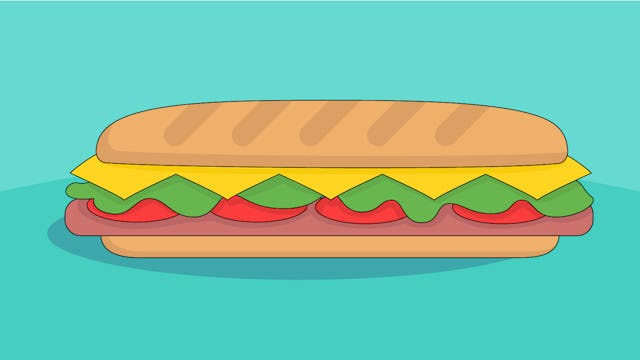39 Weeks Pregnant — Your Baby Is The Size Of A Party Sub

The contents of this article have been medically reviewed by Ruth A. Tessler, M.D. in July, 2019.
Welcome to Scary Mommy’s pregnancy week by week guide! We’re here to give you all the info about what to expect when you’re expecting: be it symptoms, your pregnancy week by week size and development, your changing body, or ultrasounds and appointments. Here’s everything you need to know about week 39.
Your Body at Week 39 Pregnant
Congrats, You’re Full Term!
Welp, you’re almost there. Your due date is soooo close you can almost feel it. If you buy milk, the expiration date will likely be after your due date, which could make you feel awesome and excited, or apprehensive and a little freaked out. Rest assured, all of these feelings are totally normal.
Now that you’re 39 weeks pregnant, you are considered full term and it’s safe to deliver your baby at any moment. Huzzah! The American College of Obstetricians and Gynecologists redefined the phrase “full term” in 2013 to cover those who are 39 weeks pregnant to 40 weeks and 6 days, and right now, mama, you qualify. If this was a twin pregnancy, you’d be holding two babies already!
You’re Still Running Out of Room
Of course, if you aren’t in active labor at this very moment, your baby is still packing on the ounces — so you’re even more full of baby this week than you were last week. According to the ACOG, there’s about a half pound of weight gain per week during the last month of pregnancy. That means the difference in fetal weight over a two-week period is an entire pound of baby. Another fun fact: There’s less room in your uterus for big, dramatic kicks, but your baby is still moving and stretching, and that can hurt.
Your Baby at Week 39 Pregnant
Your full-term status means there’s a full-term infant residing inside your body at this very moment. Lungs are good to go, and every other body system is fully grown and developed. That half pound of weight gain per week mentioned above is mainly in the form of sweet, squishy baby fat being deposited all over your babe’s body, which will help with temperature regulation after birth.
Baby sizes can vary quite a bit at this stage in the game. Your baby is probably between 18 and 20 ½ inches long, and can weigh between 6 ½ to 8 pounds at 39 weeks of pregnancy. If that sounds pretty big, it is — your baby is basically as big as a party sub.
Your Symptoms and Health at Week 39 Pregnant
Hello Hemorrhoid, My Old Friend
For some of us, the increased pressure of baby on the backside, those extra hormones raging around, and a sluggish gastrointestinal system gift us with swollen blood vessels in the anus and lower rectum, also known as pregnancy hemorrhoids. Though this is usually a temporary problem that often resolves after your baby is born, knowing that doesn’t make it less painful or annoying while it’s affecting your butt.
Make sure you’re getting enough fluids (yes, even though you’re already peeing constantly) and definitely eat plenty of fiber-rich foods. Walk around when you can, too, as sitting or standing in one position for long periods of time can exacerbate the problem. (Plus, walking is a great way to naturally induce labor, as it brings the baby lower in your cervix.) You can also try sitting in a few inches of warm water, or consider using ice packs or cold compresses to help with swelling. If you’re having major issues, though, don’t hesitate to call your provider — trust us, they’ve definitely heard it all before, so don’t be embarrassed to talk about your swollen butthole problems.
Are These Real Contractions?
Any day, labor can begin, and it’s important to be able to recognize real labor contractions and how to differentiate them from the “annoying and possibly painful, but not-in-labor” contractions you may have been experiencing for a few weeks now.
Real labor contractions come at regular intervals, eventually get closer together, and steadily increase in strength. They don’t let up if you move positions, either, so if you think you’ve got something going and you shift and they go away, it’s not the real thing.
False labor contractions tend to be irregular and they don’t increase in frequency or strength. If they peter out after an hour of getting your hopes up, well, your hopes have been dashed — for now. Keep in mind that not every pregnant person has a textbook labor, either. If your doctor has told you to head to the hospital or birth center when your contractions are regular and 5 minutes apart, but your pattern isn’t regular or you’re not sure, give them a call or head in.
The contents of this article have been medically reviewed by Ruth A. Tessler, M.D. in July, 2019.
Written by Monica Beyer.
Follow Preggo Nancy’s pregnancy journey week-by-week and share in her joy, her symptoms, and even her pregnancy cravings.
Read More:
38 Weeks Pregnant — Your Baby Is The Size Of A Sheet Of Cookies
40 Weeks Pregnant — Your Baby Is The Size Of A Turducken
This article was originally published on